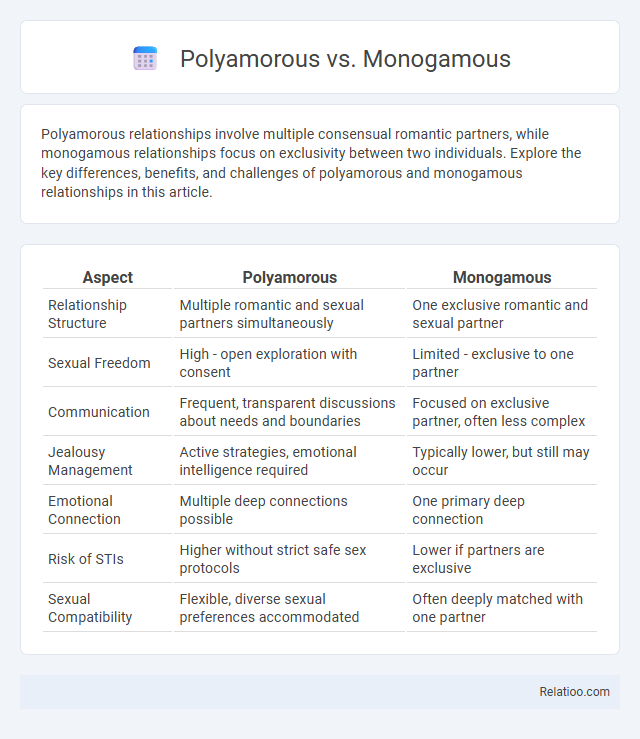Polyamorous relationships involve multiple consensual romantic partners, while monogamous relationships focus on exclusivity between two individuals. Explore the key differences, benefits, and challenges of polyamorous and monogamous relationships in this article.
Table of Comparison
| Aspect | Polyamorous | Monogamous |
|---|---|---|
| Relationship Structure | Multiple romantic and sexual partners simultaneously | One exclusive romantic and sexual partner |
| Sexual Freedom | High - open exploration with consent | Limited - exclusive to one partner |
| Communication | Frequent, transparent discussions about needs and boundaries | Focused on exclusive partner, often less complex |
| Jealousy Management | Active strategies, emotional intelligence required | Typically lower, but still may occur |
| Emotional Connection | Multiple deep connections possible | One primary deep connection |
| Risk of STIs | Higher without strict safe sex protocols | Lower if partners are exclusive |
| Sexual Compatibility | Flexible, diverse sexual preferences accommodated | Often deeply matched with one partner |
Understanding Polyamory and Monogamy
Polyamory involves engaging in multiple consensual romantic relationships simultaneously, emphasizing open communication and emotional honesty. Monogamy centers on exclusive romantic commitment between two partners, fostering trust and stability within a singular relationship. Understanding your preferences between polyamory and monogamy requires exploring boundaries and openness to emotional connections beyond conventional norms.
Historical Perspectives on Relationship Structures
Historical perspectives on relationship structures reveal polyamorous arrangements dating back to indigenous cultures and ancient civilizations, where multiple partnerships were often intertwined with social and spiritual practices. Monogamous relationships became dominant in many societies due to religious doctrines, legal systems, and economic factors emphasizing exclusive pair bonding. Sexual openness varies across cultures and eras, with periods of liberal attitudes during the Renaissance and the 20th century's sexual revolution contrasting with more restrictive norms in Victorian and other conservative contexts.
Key Differences Between Polyamorous and Monogamous Relationships
Polyamorous relationships involve multiple consensual romantic or sexual partners, emphasizing open communication, emotional transparency, and negotiated boundaries, contrasting with monogamous relationships, which center on exclusivity between two partners. The key differences include the structure of commitment, where monogamy fosters singular exclusivity while polyamory supports multiple attachments, and how jealousy and trust are managed through different strategies. Understanding these dynamics can help you navigate relationship expectations and foster healthier connections tailored to your personal values and needs.
Communication in Polyamorous vs Monogamous Partnerships
Effective communication is essential in polyamorous partnerships where multiple relationships require transparent boundaries, emotional honesty, and continual negotiation to maintain trust and consent. In monogamous relationships, communication often focuses on deepening intimacy and resolving conflicts between two partners with shared expectations of exclusivity. Sexual openness in polyamory necessitates proactive dialogue about desires and safe practices, contrasting with monogamous norms that may emphasize exclusivity and implicit trust.
Emotional Dynamics: Jealousy and Compersion
Polyamorous relationships often encourage compersion, where you feel joy from your partner's happiness with others, fostering emotional openness and reducing jealousy. Monogamous relationships typically navigate jealousy as a natural response to exclusivity, requiring trust and communication to maintain emotional security. Sexual openness varies in these dynamics, influencing how jealousy and compersion are managed, with polyamory promoting shared intimacy and monogamy emphasizing exclusivity and emotional focus.
Navigating Boundaries and Agreements
Navigating boundaries and agreements in polyamorous relationships requires clear communication and mutual respect to accommodate multiple partnerships while honoring each person's needs. In monogamous relationships, establishing exclusive commitments often involves defining limits on emotional and sexual interactions to maintain trust and security. Sexual openness varies individually, demanding tailored agreements that prioritize consent and transparency to balance personal freedom with relationship stability.
Societal Attitudes and Cultural Influences
Societal attitudes toward polyamorous, monogamous, and sexually open relationships vary significantly across cultures, often shaped by historical norms, religious beliefs, and legal frameworks. Monogamy remains the predominant model in many societies due to deep-rooted cultural traditions and institutional recognition, while polyamory challenges conventional views by emphasizing multiple consensual partnerships, frequently facing stigma and legal ambiguity. Sexual openness, intersecting with both monogamous and polyamorous arrangements, reflects evolving cultural narratives about individual freedom, consent, and the diversification of relationship structures in contemporary social discourse.
Common Myths and Misconceptions
Polyamorous relationships are often misunderstood as being inherently less stable or less loving than monogamous ones, despite research showing that commitment and communication are key factors in relationship satisfaction across all types. A common myth is that sexual openness equates to promiscuity, whereas many individuals in open relationships maintain clear boundaries and ethical agreements to honor trust and respect. Misconceptions about monogamy include the belief that it is the only ethical or socially acceptable relationship model, overlooking the validity and success of diverse relationship structures such as polyamory and consensual non-monogamy.
Benefits and Challenges of Each Relationship Style
Polyamorous relationships offer increased emotional support and diverse connections but require strong communication and trust to manage jealousy and time commitments. Monogamous relationships provide stability and clear boundaries, fostering deep emotional intimacy, yet they may face challenges like monotony or unmet social needs. Understanding your comfort with sexual openness helps tailor your relationship style, balancing personal fulfillment with boundaries to enhance overall satisfaction.
Choosing What Works: Personal Compatibility and Values
Choosing between polyamorous, monogamous, or sexually open relationships depends heavily on individual compatibility and core values. Research shows that relationship satisfaction increases when partners share similar attitudes toward commitment, exclusivity, and communication styles. Prioritizing honest self-assessment and boundary-setting helps individuals align their relationship structure with personal emotional needs and lifestyle preferences.

Infographic: Polyamorous vs Monogamous
 relatioo.com
relatioo.com